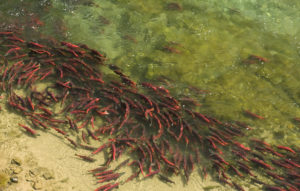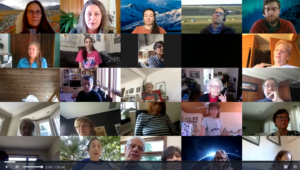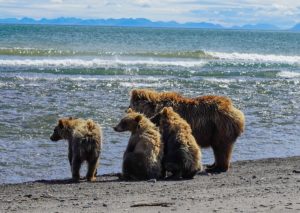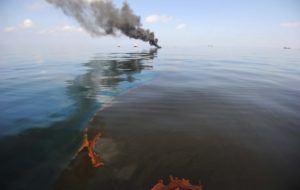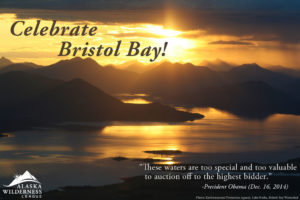BRISTOL BAY
Todd Radenbaugh
WHY TO LOVE THIS PLACE
Bristol Bay is the largest commercial sockeye salmon producing region in the world and home to one of the most prolific king salmon runs left on Earth. Roughly the size of West Virginia, the Bristol Bay Watershed includes nine major river systems tucked between Katmai National Park, Lake Clark National Park and the nation’s largest state park — Wood-Tikchik State Park.
LOCATION

HOT SPOT
Bristol Bay is located along the Pacific Ring of Fire and home to three active volcanoes: Mt. Veniaminof, Iliamna and Redoubt.
GREAT LAKE
Lake Iliamna is the largest lake in Alaska, and the third largest lake located completely within the borders of the United States.
BEAR CENTRAL
Bristol Bay is home to the world’s greatest concentration of giant coastal grizzly (brown) bears — and there's a reason for that.
ECONOMIC ENGINE
The combined Bristol Bay fishery is valued at $1.5 billion and supports more than 14,000 jobs.
THE GREAT OUTDOORS
Recreation and tourism spending in Bristol Bay bring in $90 million in revenue annually to Alaska.
THE FIGHT TO PROTECT BRISTOL BAY FROM THE PROPOSED PEBBLE MINE
Pebble Mine is a massive proposed copper, gold and other mineral mine in the Bristol Bay region of Southwest Alaska. If fully developed, Pebble Mine could produce 10.2 billion tons of toxic waste that will be stored at the headwaters of the Bristol Bay Watershed forever. Even a small amount of the poisonous acid and toxic waste runoff from the mine will destroy the salmon habitat and the Alaskans who rely on it. And taxpayers will be left with the bill to clean up the destruction.
Environmental impact studies say the mine will directly impact thousands of acres of wetlands and hundreds of miles of streams, and the Environmental Protection Agency concluded that any mining would pose an irreversible risk to species in the area.
In 2020, the U.S. Army Corps of Engineers announced they had denied a permit for the proposed Pebble Mine in Alaska, determining that “the applicant’s plan for the discharge of fill material does not comply with Clean Water Act guidelines” and concluding that “the proposed project is contrary to the public interest.” Read our statement.
In 2021, Pedro Bay Corp, an Alaska Native corporation (ANC) announced that 90% of its shareholders had voted to created conservation easements on nearly half of their ancestral land in southwest Alaska. This transaction made 44,000 acres of land off limits to developers, including land needed to build the proposed mining road for the Pebble Mine project.
In January of 2023, the EPA announced that it was using a provision under the Clean Water Act to block Pebble Mine, or any similar developers, protecting the region’s world class fisheries from the anticipated mining discharges associated with the Pebble deposit.
LATEST BRISTOL BAY HIGHLIGHTS
Victorious: The Magic of Bristol Bay
Alaska Wilderness League and filmmaker Mark Titus present a true “Geography of Hope” in Bristol Bay, Alaska. This virtual celebration of our recent victory protecting Bristol Bay from the proposed Pebble Mine showcases vibrant videos, images and stories about what it means to be connected to this magical region and its salmon.
Press Release: President Biden, EPA Secures Southwest Alaska’s Salmon Future
Today, the U.S. Environmental Protection Agency issued a final decision prohibiting the construction of the massive Pebble mine in the world-famous headwaters of Alaska’s Bristol Bay.
Joe Biden supports 30×30. He should start in Alaska.
Recently we’ve been seeing great news for the environment coming out of Washington, D.C.
Biden opens the door to protecting the Arctic Refuge
This piece originally appeared in The Hill. (Cover photo: Porcupine caribou on the coastal plain of the Arctic National Wildlife Refuge — Florian Schulz/www.florianschulz.org)
A bipartisan need for conservation
(This essay was provided to the League for reprint by Theodore Roosevelt IV, great-grandson of President Teddy Roosevelt. The essay was written in the first quarter of 2020 and appeared in The Explorers Log, Volume 52.1, Winter 2020. Cover image: Lincoln Else.)
Forging connections through a “Geography of Hope”
For many of us, Alaska represents what author Wallace Stegner called “the geography of hope,” a place that captivates and inspires millions who feel our country is richer for having truly wild, vast and largely intact landscapes where herds of healthy wildlife still roam freely. Where Indigenous peoples live in deep harmony with the land…
Protect Bristol Bay
For more than a decade, the threat of North America’s largest copper and gold mine has loomed over the headwaters of Bristol Bay, Alaska.
North To The Future: Alaska And The Risks Of Pursuing A Trump Legacy
(This blog originally appeared on the American College of Environmental Lawyers website.) On the last Friday in March, Judge Sharon Gleason of the Federal District Court for the District of Alaska issued two opinions in closely-watched cases* concerning federal public lands and waters in and offshore of Alaska.
It Begins With The Sea. And If We’re Not Careful, That’s Where It All Will End.
(Written by Alaska Wilderness League Guardian and author John Copp. John is a former software engineer who has spent many years fishing Bristol Bay, and studying marine life and subsistence hunting. John’s new novel is an action-thriller about saving imperiled goose populations on Alaska’s Yukon Delta National Wildlife Refuge.)
Thank You, President Obama, For Protecting Bristol Bay!
Four years ago, President Obama first moved to protect Bristol Bay from oil and gas leasing, calling it a “national treasure.” Earlier this week, President Obama made that protection permanent – ensuring that one of the world’s largest wild salmon runs and a tremendous economic driver for Alaska will be protected now and into the future!…


